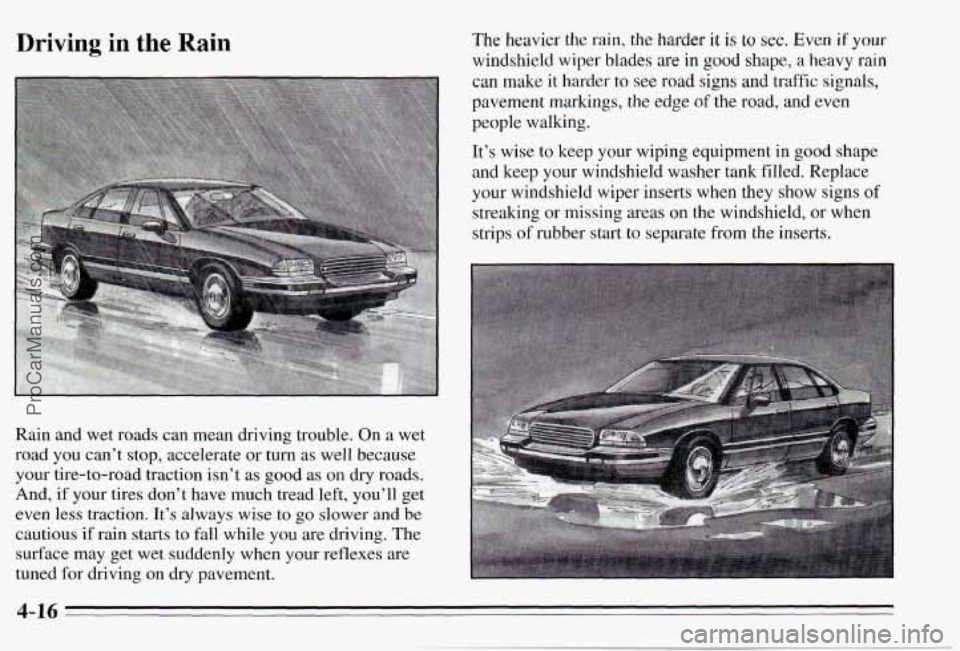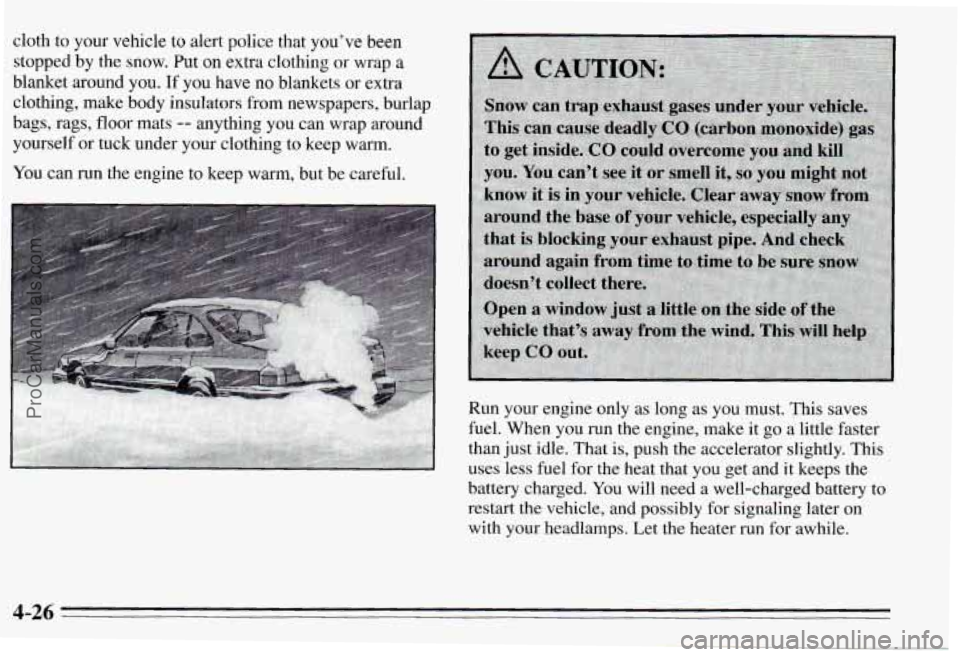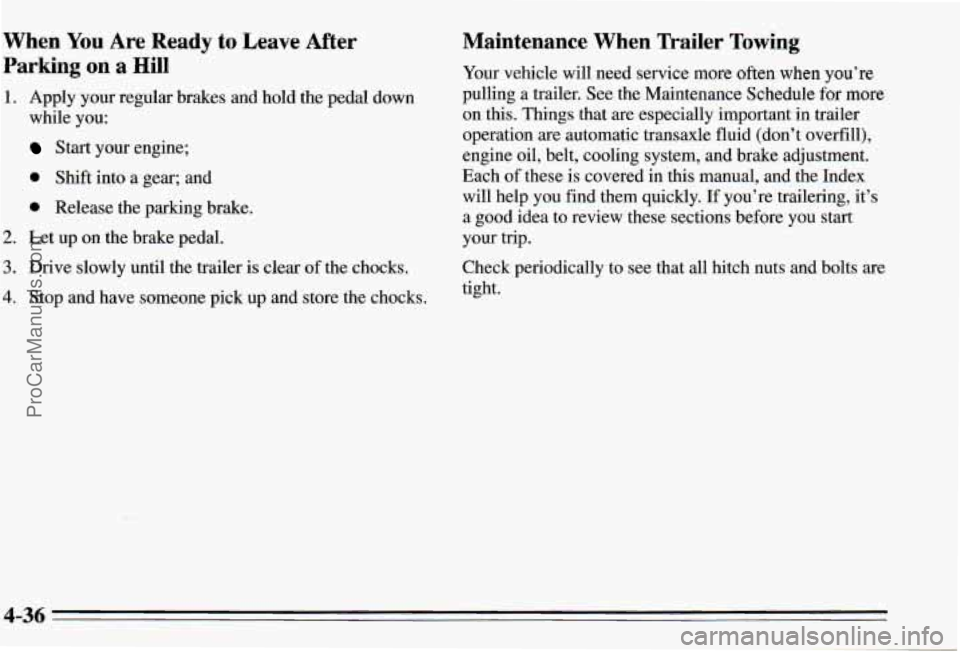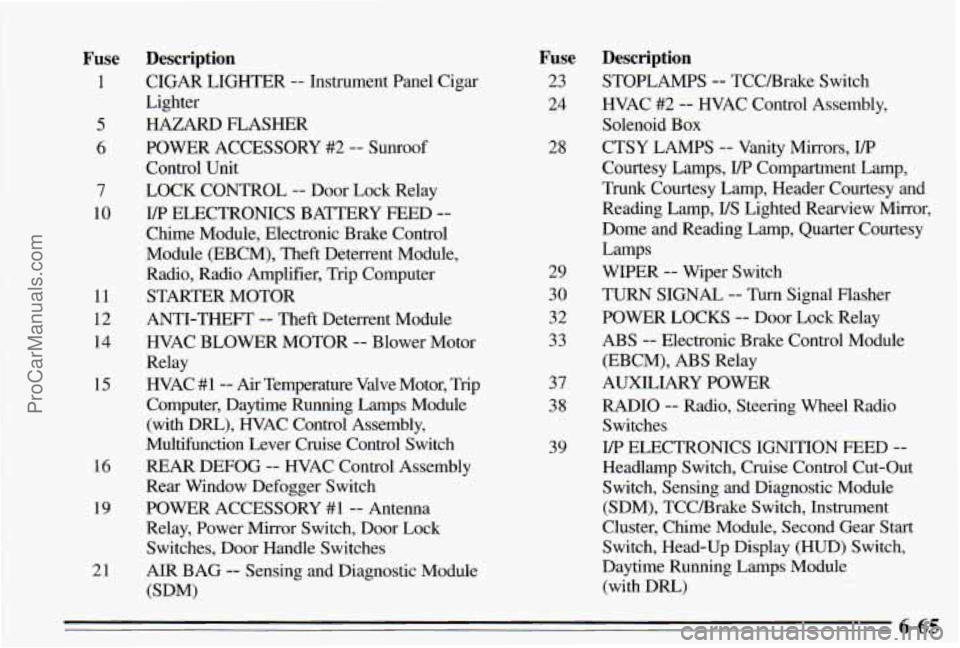1995 PONTIAC PONTIAC stop start
[x] Cancel search: stop startPage 159 of 354

Driving in the Rain
Rain and wet roads can mean driving trouble. On a wet
road you can’t stop, accelerate or turn as well because
your tire-to-road traction isn’t as good as
on dry roads.
And,
if your tires don’t have much tread left, you’ll get
even less traction. It’s always wise to go slower
and be
cautious
if rain starts to fall while you are driving. The
surface may get wet suddenly when your reflexes are
tuned for driving on dry pavement.
The heavier the rain, the harder it is to see. Even if your
windshield wiper blades
are in good shape, a heavy rain
can make it harder to see road signs and traffic signals,
pavement markings, the edge
of the road, and even
people walking.
It’s wise to keep your wiping equipment in good shape
and keep your windshield washer tank filled. Replace
your windshield wiper inserts when they show signs of streaking or missing areas on the windshield, or when
strips
of rubber start to separate from the inserts.
4-16
ProCarManuals.com
Page 163 of 354

Once you are moving on the freeway, make certain you
allow
a reasonable following distance, Expect to move
slightly slower at
night.
When you want to leave the freeway, move to the proper
lane well in advance.
If you miss your exit do not, under
any circumstances, stop and back up. Drive on to the
next exit.
The exit ramp can be curved, sometimes quite sharply.
The exit speed is usually posted.
Reduce
your speed according to your speedometer, not
to your sense of motion. After driving
for any distance
at higher speeds, you may tend to think you are going
slower than you actually are.
Before Leaving on a Long Trip
Make sure you’re ready. Try to be well rested. If you
must start when you’re not fresh
-- such as after a day’s
work
-- don’t plan to make too many miles that first part
of the journey. Wear comfortable clothing and shoes you
can easily drive in.
Is your vehicle ready for a long trip? If you keep it
serviced and maintained, it’s ready to go. If it needs
service,
have it done before starting out. Of course,
you’ll find experienced and able service experts in
Pontiac dealers
all across North America. They’ll..be
ready and willing
to help if you need it.
Here are some things you can check before a trip:
e
0
0
0
0
e
0
Windshield Washer Fluid: Is the reservoir full? Are
all windows clean inside and outside?
Wiper Blades: Are they in good shape?
Fuel, Engine Oil, Other Fluids: Have you checked
all levels?
Lamps: Are they all working? Are the lenses clean?
Tires: They are vitally important to a safe,
trouble-free trip.
Is the tread good enough for
long-distance driving? Are the tires all inflated to the
recommended pressure?
Weather Forecasts: What’s the weather outlook
along your route? Should you delay your
trip a short
time to avoid a major storm system?
Maps: Do you have up-to-date maps?
4-20
ProCarManuals.com
Page 169 of 354

cloth to your vehicle to alert police that you’ve been stopped by the snow. Put
on extra clothing or wrap a
blanket around you.
If you have no blankets or extra
clothing, make body insulators from newspapers, burlap
bags, rags, floor mats
-- anything you can wrap around
yourself or tuck under your clothing to keep warm.
You can run the engine to keep warm, but be careful.
Run your engine only as long as you must. This
saves
fuel. When you run the engine, make it go a little faster
than just idle. That
is, push the accelerator slightly. This
uses less fuel for the heat that you get and it keeps the
battery charged. You will need a well-charged battery to
restart the vehicle, and possibly for signaling later on
with your headlamps. Let the heater run for awhile.
4-26
ProCarManuals.com
Page 179 of 354

When You Are Ready to Leave After
Parking on a Hill
1. Apply your regular brakes and hold the pedal down
while you:
Start your engine;
0 Shift into a gear; and
0 Release the parking brake.
2. Let up on the brake pedal.
3. Drive slowly until the trailer is clear of the chocks.
4. Stop and have someone pick up and store the chocks.
Maintenance When Trailer Towing
Your vehicle will need service more often when you’re
pulling
a trailer. See the Maintenance Schedule for more
on this. Things that are especially important in trailer
operation are automatic transaxle fluid (don’t overfill),
engine oil, belt, cooling system, and brake adjustment.
Each
of these is covered in this manual, and the Index
will help you find them quickly.
If you’re trailering, it’s
a good idea to review these sections before
you start
your trip.
Check periodically to see that all hitch nuts and bolts are
tight.
ProCarManuals.com
Page 278 of 354

Fuse
1
5
6
7
10
11
12 14
15
16
19
21
Description
CIGAR LIGHTER -- Instrument Panel Cigar
Lighter
HAZARD FLASHER
Control Unit
LOCK CONTROL
-- Door Lock Relay
Chime Module, Electronic Brake Control
Module (EBCM), Theft Deterrent Module,
Radio, Radio Amplifier, Trip Computer
STARTER MOTOR
ANTI-THEFT
-- Theft Deterrent Module
WAC BLOWER MOTOR
-- Blower Motor
Relay
WAC
#1-- Air Temperature Valve Motor, Trip
Computer, Daytime Running Lamps Module
(with Dm), WAC Control Assembly,
Multifunction Lever Cruise Control Switch
REAR DEFOG -- WAC Control Assembly
Rear Window Defogger Switch
POWER ACCESSORY
#1 -- Antenna
Relay, Power Mirror Switch, Door Lock Switches, Door Handle Switches
AIR BAG -- Sensing and Diagnostic Module
@DM)
POWER ACCESSORY
#2 -- SUIKOO~
YP ELECTRONICS
BATTERY FEED --
Fuse
23
24
28
29
30
32
33
37
38
39
Description
STOPLAMPS -- TCCBrake Switch
HVAC #2
-- HVAC Control Assembly,
Solenoid Box
CTSY LAMPS
-- Vanity Mirrors, VP
Courtesy Lamps, I/P Compartment Lamp,
Trunk Courtesy Lamp, Header Courtesy and
Reading Lamp,
US Lighted Rearview Mirror,
Dome and Reading Lamp, Quarter Courtesy
WIPER
-- Wiper Switch
TURN SIGNAL
-- Turn Signal Flasher
POWER LOCKS
-- Door Lock Relay
ABS -- Electronic Brake Control Module
(EBCM),
ABS Relay
AUXILIARY POWER
RADIO
-- Radio, Steering Wheel Radio
Switches
Headlamp Switch, Cruise Control Cut-Out Switch, Sensing and Diagnostic Module
(SDM), TCCBrake Switch, Instrument
Cluster, Chime Module, Second Gear Start
Switch, Head-Up Display
(HUD) Switch,
Daytime Running Lamps Module
(with Dm)
Lamps
I/P ELECTRONICS IGNITION FEED --
6-65 ProCarManuals.com
Page 343 of 354

Shifting .................................... 2- 16
Third Gear (3) Position
........................ 2-18
Automatic Transaxle Fluid
........................ 6- 16
Adding
.................................... 6-18
Checking ................................... 6-16
Battery
...................................... 6-28
Charge Light
................................ 2-50
Jump Starting
................................ 5-2
Replacement. Remote Lock Control
............... 2-7
Saver
...................................... 2-36
Warnings
.................................... 5-2
BBB Auto Line
................................. 8-3
Blizzard
...................................... 4-25
Brake Adiustment
................................. 6-27
Fliid. Adding
............................... 6-26
Master Cylinder
............................. 6-25
System Parts, Replacing
....................... 6-27
System Warning Light
........................ 2-52
Trailer
..................................... 4-33
Transaxle Shift Interlock
....................... 2-24
Transaxle Shift Interlock, Maintenance
........... 7-37
Brakes, Anti-Lock
............................... 4-6
Braking
........................................ 4-5
Braking, In Emergencies
.......................... 4-9
Break-In,
New Vehicle .......................... 2-12
Parking
.................................... 2-21
PedalTravel
................................ 6-27
Wear
...................................... 6-26 BTSI (Brake Transaxle Shift Interlock)
.............. 2-24
Bulb Replacement
.............................. 6-70
BTSI (Brake Transaxle Shift InterIock). Maintenance . . 7-37
Canada. Vehicles First Sold In
11 .. .......................
Canadian Roadside Assistance ...................... 8-7
Capacities and Specifications
...................... 6-71
Carbon Monoxide
.................... 2.25.4.26. 4.32
Care
of the Head-Up Display ..................... 3-15
Cassette Tape Player
............................. 3-9
Cassette Tape Player Care ........................ 3-15
CDPlayer
..................................... 3-10
Center Console
................................. 2-41
Center High-Mounted Stoplamp Bulb Replacement
.... 6-42
Center Passenger Position
........................ 1-29
Certification Label
.............................. 4-27
Chains, Safety
................................. 4-32
Chains, Tire ................................... 6-54
Changing
a Flat Tire ............................. 5-23
Charging System Light
.......................... 2-50
Checking Your Restraint Systems
.................. 1-54
Automatic Transaxle Fluid
..................... 6-16
Engine Coolant
.............................. 6-20
EngineOil
.................................. 6-11
Power Steering Fluid
......................... 6-22
Restraint Systems
............................ 1-54
Chemical Paint Spotting
.......................... 6-61
Checking
BrakeFluid
................................. 6-25
Things Under the Hood
......................... 6-7
ProCarManuals.com